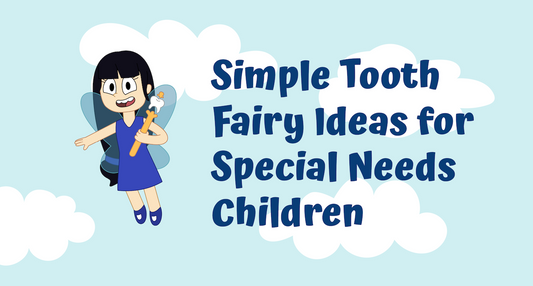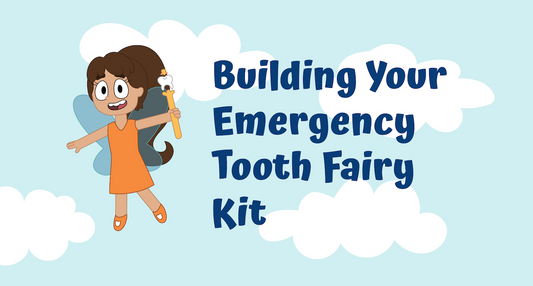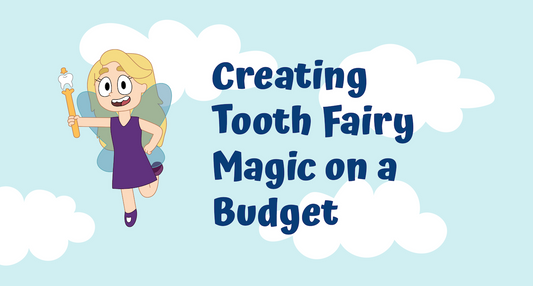That moment when your child announces their first tooth is wiggly marks a significant milestone—both for them and for you as a parent. This exciting developmental step signals the transition from early childhood into the school-age years, but it can also bring anxiety, questions, and the need for careful preparation. This comprehensive guide walks you through everything you need to know to handle your child's first loose tooth with confidence, creating a positive experience that sets the tone for all future tooth fairy visits.
Recognizing the Signs: When to Expect the First Loose Tooth
Most children lose their first tooth between ages 5 and 7, though the timeline can vary significantly. Understanding what to watch for helps you prepare:
Typical Age Ranges:
- Early losers (ages 4-5): Perfectly normal, often children who got teeth early as babies
- Average range (ages 6-7): Most common timeframe for first tooth loss
- Late bloomers (ages 7-8): Also completely normal, often indicates strong root development
Physical Signs to Watch For:
- Visible gap appearing around the tooth
- The tooth appearing slightly raised or protruding
- Your child naturally favoring one side while eating
- Increased interest in touching or wiggling the tooth
- Minor discomfort or sensitivity while eating certain foods
Behavioral Indicators:
- Sudden awareness of teeth and frequent tongue exploration
- Questions about when teeth fall out
- Excitement or anxiety about the tooth fairy
- Comparing their teeth to siblings or friends
Understanding your child's complete tooth loss timeline helps you prepare for this milestone and future tooth fairy visits.
Emotional Preparation: Helping Your Child Process the Experience
The first loose tooth can trigger a range of emotions in children, from excitement to genuine fear. Your response during this time shapes their attitude toward this developmental milestone:
Addressing Common Fears
"Will it hurt when it falls out?" Reassure your child that losing a tooth is a natural process that usually doesn't hurt. Explain that they might feel a little pressure or strange sensation, but it's similar to how a scab falls off a scraped knee.
"What if I swallow it?" Let them know that swallowing a tooth is completely safe and happens to many children. The tooth fairy understands these situations and has special procedures for swallowed teeth.
"Will my new tooth grow back?" Explain that losing baby teeth makes room for bigger, stronger adult teeth that will last their whole life. Show them pictures of adult smiles to demonstrate how beautiful permanent teeth look.
Building Excitement
Create Anticipation: Talk about how losing their first tooth means they're growing up and becoming a "big kid."
Share Stories: Tell them about your own first tooth experience or stories from siblings and relatives.
Introduce the Tooth Fairy: Begin sharing tooth fairy traditions and building excitement about this magical visitor.
Physical Preparation: What You Need to Know
The Natural Loosening Process
Timeline: A tooth typically takes 2-3 weeks to naturally loosen enough to fall out on its own.
What's Normal:
- Gradual increase in wiggliness over several days or weeks
- Minor bleeding around the gum line (very small amounts)
- Slight discomfort while eating hard or crunchy foods
- The tooth becoming more mobile but still attached
When to Be Concerned:
- Excessive bleeding that doesn't stop within a few minutes
- Signs of infection (swelling, fever, severe pain)
- Trauma that causes sudden loosening
- The tooth becoming extremely loose very quickly (within 24 hours)
To Pull or Not to Pull?
The Natural Approach (Recommended): Allow the tooth to fall out naturally. This ensures:
- Minimal discomfort for your child
- Proper timing for the permanent tooth's emergence
- Reduced risk of bleeding or complications
- A more positive experience overall
When Intervention Might Be Needed:
- The tooth is hanging by a thread and bothering your child
- It's been extremely loose for over a week and interfering with eating
- Your dentist has recommended removal
- The permanent tooth is already visible behind the baby tooth
Safe Removal Techniques (if necessary):
- Wash hands thoroughly
- Use a clean tissue or gauze for grip
- Apply gentle, steady pressure in the direction the tooth naturally wants to move
- Stop immediately if your child experiences significant discomfort
Creating Your First Tooth Fairy Plan
The first tooth fairy visit is special and sets expectations for all future visits. Planning ahead ensures a magical experience:
Establishing Your Family's Tooth Fairy Tradition
Choose Your Approach:
- Classic exchange: Simple money or small gift under the pillow
- Elaborate magic: Fairy dust trails, tiny notes, and special effects
- Educational focus: Gifts that emphasize dental health and growing up
- Cultural variation: Incorporating global tooth traditions into your family's practice
Set Your "Exchange Rate": Research current tooth fairy economics in your area, but choose an amount that works for your family's budget and values. Remember, you'll be maintaining this tradition for approximately 20 teeth over several years.
Create Consistency: Whatever approach you choose for the first tooth should be sustainable for future visits. It's easier to start simple and occasionally add special touches than to start elaborate and struggle to maintain that level.
First Tooth Special Considerations
Extra Special Treatment: Many families make the first tooth extra special with:
- A higher monetary value or special gift
- A personalized letter from the tooth fairy
- A small ceremony or celebration
- Photos to commemorate the milestone
- Special tooth fairy accessories (pillow, container, etc.)
Documentation Opportunities:
- Take "before and after" photos of your child's smile
- Start a tooth fairy memory collection
- Create a tooth loss tracking chart
- Begin a tooth fairy journal for ongoing communication
Practical Logistics for the Big Night
Pre-Tooth Loss Preparation
Gather Supplies:
- Appropriate money or gifts for the exchange
- Small paper and pen for tooth fairy notes
- Camera for documenting the milestone
- Any special tooth fairy accessories you plan to use
- Backup supplies in case of mishaps
Set Up Systems:
- Choose where the tooth will be placed (under pillow, special container, etc.)
- Plan your approach for the nighttime exchange
- Set phone reminders so you don't forget
- Prepare any special magical elements you want to include
The Day the Tooth Falls Out
Stay Calm and Positive: Your reaction sets the tone for your child's experience. Even if there's blood or the tooth falls out at an inconvenient time, maintain enthusiasm about this milestone.
Handle the Physical Aspects:
- If there's bleeding, apply gentle pressure with clean gauze
- Rinse your child's mouth with cool water
- Give soft foods for the first few hours if the area is tender
- Save the tooth in a safe place until bedtime
Build Excitement:
- Celebrate the milestone with special attention
- Take photos of their new gap-toothed smile
- Talk about what the tooth fairy might bring
- Let them help prepare for the tooth fairy's visit
The Tooth Fairy Visit
Timing Your Approach:
- Wait until your child is soundly asleep (at least 30-60 minutes)
- Move quietly and use minimal lighting
- Have everything prepared beforehand to minimize time spent in the room
Making the Exchange:
- Carefully retrieve the tooth (save it if you want to keep it as a memento)
- Leave the money or gift in its place
- Add any special touches like fairy dust or notes
- Take a quick photo if you want to document the setup
Creating Magic:
- Consider leaving tiny "footprints" with baby powder
- Sprinkle a small amount of glitter for "fairy dust"
- Leave a brief, encouraging note from the tooth fairy
- Position items thoughtfully for maximum impact when discovered
The Morning After: Maximizing the Magic
The Discovery Moment
Be Present: Try to be available when your child wakes up and discovers what the tooth fairy left.
Capture the Reaction: Take photos or videos of their excitement and surprise.
Ask Questions: "What did the tooth fairy leave? How do you think she got into our house? What do you think she'll do with your tooth?"
Extend the Magic: Read any tooth fairy notes together and discuss what this milestone means.
Sharing the News
Family Celebration: Let your child call grandparents or other family members to share the exciting news.
School Sharing: Prepare your child to share their experience with teachers and friends.
Documentation: Add photos and details to any tooth fairy journals or memory books you're maintaining.
Preparing for Future Tooth Fairy Visits
Setting Expectations
Consistency: Explain that the tooth fairy will continue to visit for each lost tooth, though the gifts might vary slightly.
Timing: Help your child understand that teeth usually fall out gradually over several years.
Special Occasions: Let them know that some teeth might be extra special (like the last baby tooth).
Building on Success
Learn from the Experience: Note what worked well and what you might adjust for future visits.
Maintain Supplies: Keep tooth fairy supplies stocked and easily accessible.
Adapt as Needed: Be prepared to modify your approach as your child grows and their needs change.
Common First Tooth Scenarios and Solutions
The Tooth Falls Out at School
Preparation: Send a special container in your child's backpack for safely storing lost teeth.
Response: Make sure your child knows to tell their teacher and save the tooth for the tooth fairy.
Follow-up: Celebrate just as enthusiastically when they get home, emphasizing that the tooth fairy visits wherever the tooth ends up.
The Tooth Gets Lost
Stay Calm: Explain that the tooth fairy has special magic for finding lost teeth.
Create a Note: Help your child write a letter explaining what happened.
Maintain Magic: The tooth fairy can still visit and leave a gift based on the explanation.
Multiple Children and Comparison
Individual Attention: Make sure each child's first tooth gets special recognition.
Fair But Individual: Gifts don't have to be identical, but should feel equitable.
Sibling Support: Encourage older children to help celebrate younger siblings' milestones.
When to Consult a Professional
While tooth loss is natural, certain situations warrant dental attention:
- Tooth knocked out by trauma: See a dentist immediately to check for damage
- Excessive bleeding: If bleeding continues for more than 15-20 minutes
- Signs of infection: Swelling, fever, or severe pain around the tooth
- Very early loss: Teeth lost significantly before age 4 should be evaluated
- Delayed permanent tooth: If a permanent tooth doesn't appear within 6 months of baby tooth loss
Conclusion: Creating Lasting Memories
Your child's first loose tooth represents more than just a dental milestone—it's a rite of passage that marks their growth and development. By approaching this experience with preparation, enthusiasm, and thoughtfulness, you're creating positive associations that will influence their attitude toward growing up and taking care of their body.
Remember that perfection isn't the goal; connection and celebration are what matter most. Even if things don't go exactly as planned, your attention and effort to make this moment special will create lasting memories for both you and your child.
The first tooth loss is just the beginning of a magical journey that will span several years and approximately 20 teeth. By starting with intention and preparation, you're setting the foundation for a beloved family tradition that celebrates growth, change, and the wonder of childhood.
Want to enhance your first tooth fairy experience? The Hi Tooth Fairy app introduces children to Birdie, Frankie, Lulu, Piper, Tulip, and Winnie—the magical tooth fairies who can personally congratulate your child on this important milestone and help make the experience even more memorable.




